REMEMBERING APPU RAMAN
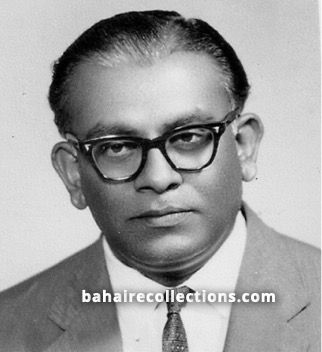
21 December 1921 – 5 January 1982
Mr. Appu Raman was one God-intoxicated servant who made the Bahá’í Faith the center of his life and served with distinction across the varied needs of the Faith, and in the process achieved unprecedented milestones for the Faith and unwittingly won for himself the love and admiration of the Bahá’ís of Malaysia and the Supreme Body.
Appu Raman who was fondly known as Raman was born in Colombo, Sri Lanka, on 21 December 1921 and came with his parents to Klang town in the state of Selangor in the then Malaya at the age of seven in 1928. In 1946, upon completion of his Senior Cambridge Examinations, he applied for a job that was advertised and one that he liked- that of Welfare Assistant in the Ministry of Welfare Services under the British colonial rule in the then Malaya. He went for a Diploma in Social Science in the University Malaya that was based in Singapore in those days. He was then transferred to Alor Star town in the state of Kedah in 1958 to take up the post of State Welfare Officer.
When Mrs Theresa Chee, the eldest daughter of Yankee Leong accepted the Faith in 1960 at a Summer School in Port Dickson in the presence of Hand of the Cause of God Dr Raḥmatu’lláh Muhájir, the much-loved Hand requested her to teach the Faith in her hometown of Alor Star. Upon returning to Alor Star, she gave the Faith to one Radhakrishnan who accepted the Faith. Radhakrishnan, unfortunately, did not remain in the Cause. But he mentioned to Theresa Chee about one Raman, a Welfare Officer and an active trainer at the St. John’s Ambulance, who had been inquiring about this new religion. Theresa met up with Raman, who, at that time while more interested in politics, was also keen to learn more about the Bahá’í Faith. She invited him to her house and introduced the Bahá’í teachings. By this time, it seems that he had already read the book “Renewal of Civilization” by David Hoffman which someone else had given him. Theresa on her part gave Raman the book “Bahá’u’lláh and the New Era” by Dr E. John Esslemont. He took the book home and read with great interest until 4:00 in the morning. Moved by the irrefutable claims of Bahá’u’lláh as the Supreme Manifestation of God for the day and His stupendous teachings so relevant to today’s failing world, Raman accepted the Faith. Although steeped in the Hindu religion, he was able to see the fulfilment of the Hindu prophecies in the coming of Bahá’u’lláh. That was the dawn of a new day in his life, and the beginning of a new chapter in the history of the Faith in Malaysia, as evidenced by the indelible traces of remarkable services Raman left behind. Both Theresa Chee and Raman became the two luminaries of the Cause in Alor Star, through whom several others accepted the Faith.
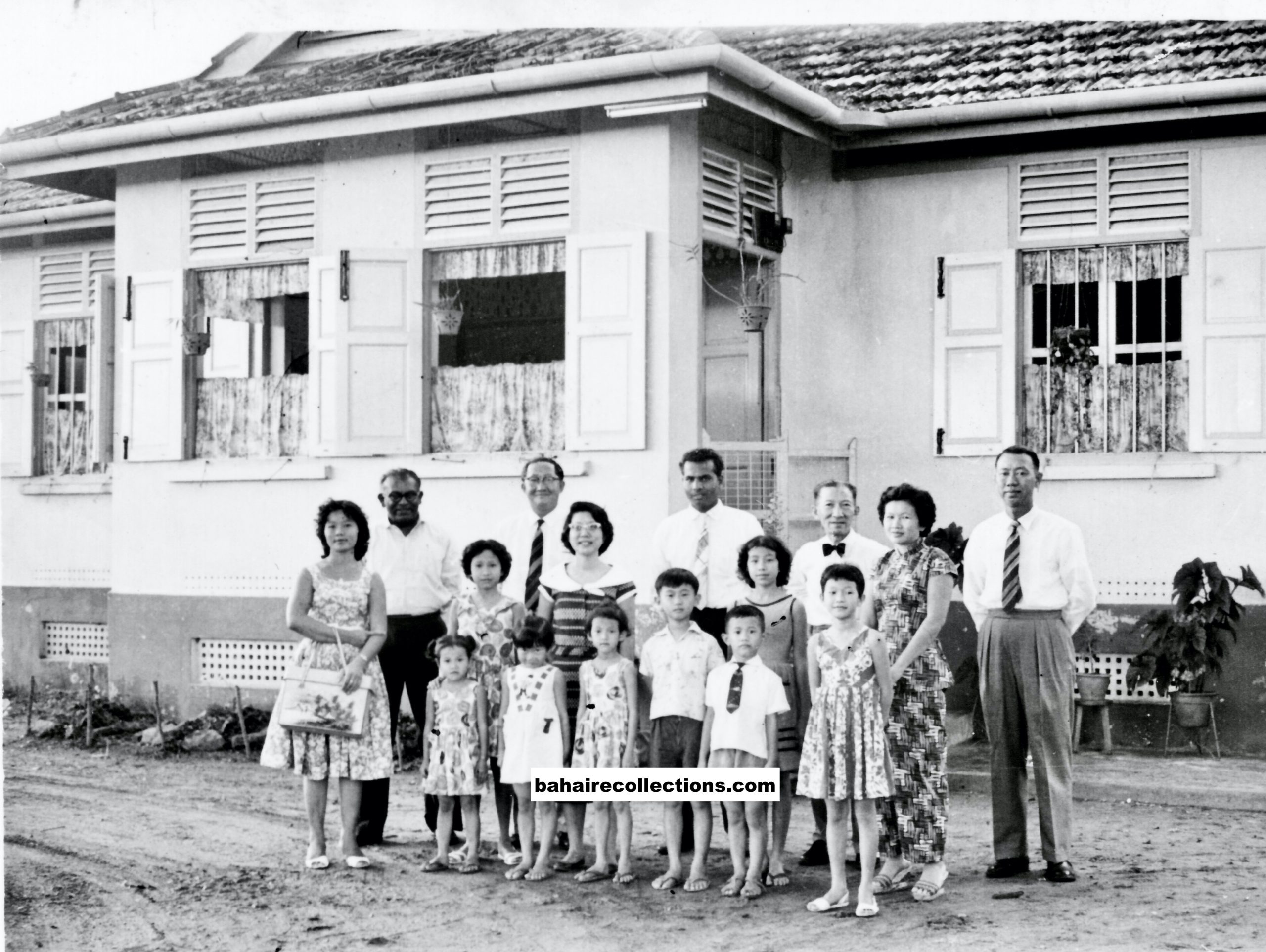
Appu Raman with the family of Theresa Chee and visiting friends, Leong Tat Chee and Yankee Leong, 1961
Upon accepting the Faith, Raman immediately cut off from his political inclination and involvement and started to labour in the path of God with inexhaustible energy that he put into all his endeavours. He read whatever books that were available to him and participated whole-heartedly in all Bahá’í activities. In Alor Star, he brought into the Faith Mr Kanniah Adaikkalam, who would in 1968 pioneer to India and later to Africa. In 1961, when the first Local Spiritual Assembly of Alor Star was elected, Raman served as its Chairman and allowed his spacious government quarters to be used as one of the meeting places for community gatherings. When Yankee Leong and Leong Tat Chee visited Alor Star to assist Theresa Chee, a promise they made when Theresa accepted the Faith in the Summer School in August 1960, Raman was delighted to meet these two dear servants of the Faith and gained a deeper understanding of the Faith.
Raman participated in a gathering held in Port Dickson in the first week of September 1961 on the occasion of the visit by the Hand of the Cause of God Amatu’l-Bahá Ruhiyyih Khanum. That gathering had an overwhelming impact on Raman, listening to Amatu’l-Bahá’s talk on several aspects of the teachings and stories of the Guardian, which he was still unaware of, given that he was a new believer. He was moved by Amatu’l-Bahá’s urging of the believers to work hard to bring to a triumphant victory the goals of the Ten-Year Crusade and thereby bring gladness to the heart of the beloved Guardian.
In the same year of 1961, Raman made a move to secure a burial ground for the Alor Star community, through one Mr Karunakaran Nair, Chairman of a Malayan Indian-based political party, a State Assemblyman, and member of the Executive Council of the Kedah State Government. Unable to deny the request of this friend whom he held in high esteem, Mr Nair gave his word that he would take up the matter with the state government.
In 1962, the Department of Social Welfare of Malaya wanted to select an officer to go the United States of America on a United Nations Fellowship Program to undergo a Rehabilitation Course for the Handicapped with a purpose of setting up a rehablitation centre in Malaya upon return. And the hardworking Raman became a natural choice, in view of the credibility he had earned in the service. And off went Raman to the United States in 1962. Back in Alor Star, Raman’s efforts paid off as the Bahá’í community obtained a burial ground in Alor Star in 1964, through follow-up efforts taken by the Local Spiritual Assembly.
While in the United States as an official from the Department of Social Welfare of Malaya, Raman took part in Bahá’í activities whenever possible. At a Youth Conference held in Michigan City in November 1962, Raman gave an enlightening talk on “The Bahá’í Faith from Hindu Perspective.” While he was an active member of the Michigan Bahá’í community during his stay there, he also managed to visit other places. Raman spent a week in Charleston city in West Virginia, visiting the Rehabilitation Center as part of his official mission, and became desirous of establishing a similar project in Malaya upon his return. In Virginia, Raman spoke at a public meeting and at five firesides, relating how Malaya got its independence and relating thrilling stories of the early growth of the Faith there.
While in the United States, Raman timed his working tour of Britain to attend the First Bahá’í World Congress in London in 1963, where he had the greatest bounty of meeting most of the living Hands of the Cause of God, whose soul-stirring talks penetrated his own soul. Witnessing the gathering of more than 6,000 Bahá’ís from all over the world was a sight to behold! Stories of the triumphant victories of the Ten-Year Crusade along with the Centenary celebrations of the Declaration of Bahá’u’lláh had a profound impact on him. That event, as he would later recall was a life-changing experience for him. As a new believer from Alor Star he had met a few other Bahá’ís from other parts of Malaya at the gathering for the visit by Amatu’l-Bahá in the first week of September 1961, but it was at this Congress that he met for the first time many other believers from other parts of the world and bonded life-long friendship with some of them. They were all believers of the Ten- Year Crusade period, an era to which Raman too belonged.
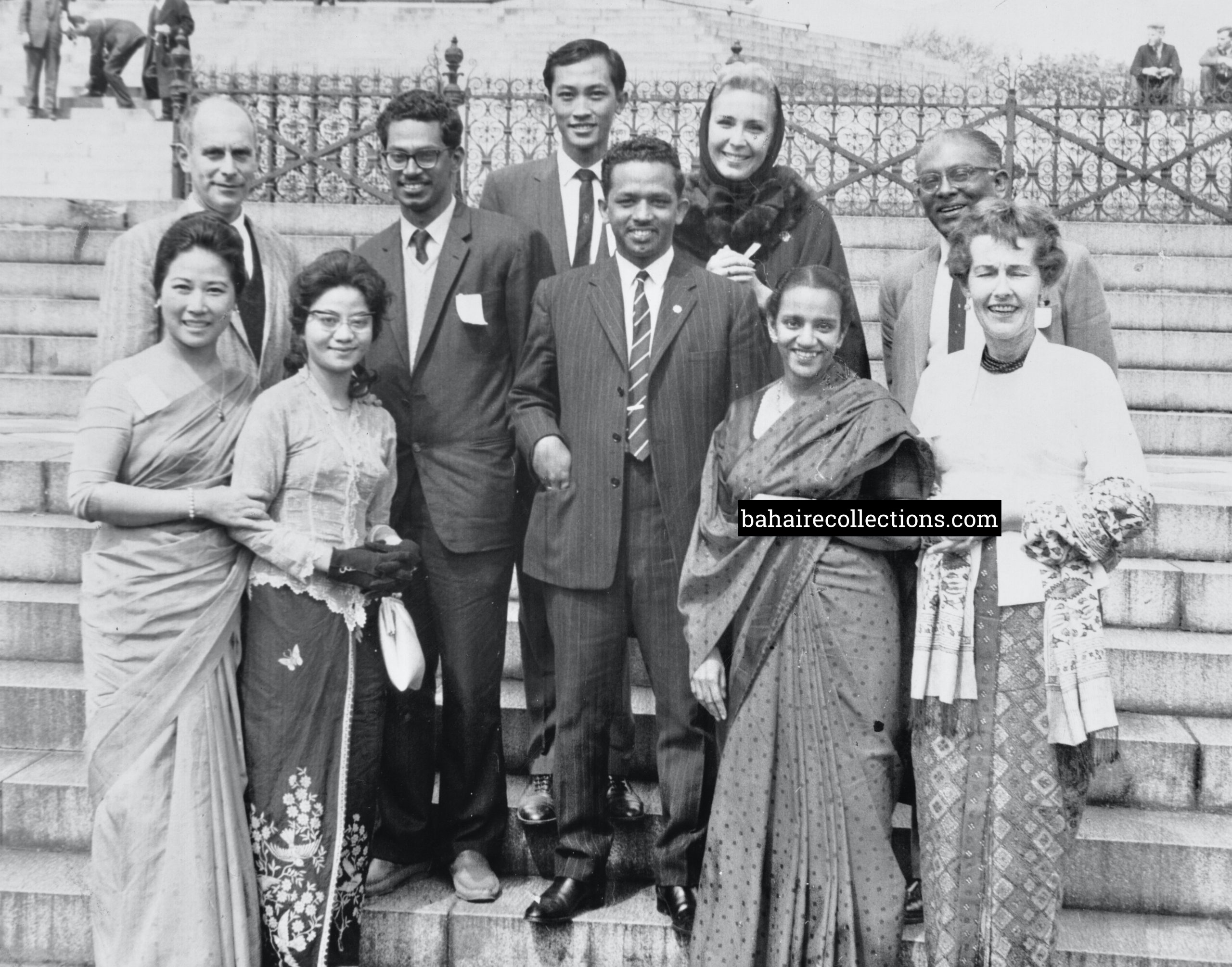 First Bahá’í World Congress in London, 1963. Back row L-R: Dr. R. J. Wolff, S. Bhaskaran, Leong Ho San, Anthony Fernandez, Jeanne Frankel and Appu Raman. Front row L-R: Lily Chinniah, Chiang Kim Lin, Shantha, and Elinor Wolff
First Bahá’í World Congress in London, 1963. Back row L-R: Dr. R. J. Wolff, S. Bhaskaran, Leong Ho San, Anthony Fernandez, Jeanne Frankel and Appu Raman. Front row L-R: Lily Chinniah, Chiang Kim Lin, Shantha, and Elinor Wolff
When Raman returned to Malaya in 1963, he was posted to Kuala Lumpur to continue as a Welfare Officer. It did not take long before he received a letter from the government appointing him to the prestigious position as the first Principal of the Rehabilitation School for the Physically Handicapped in Cheras. Raman first settled in Kajang town in the state of Selangor, and later moved into his own residence in Cheras, some nine miles from Kuala Lumpur city. He was instrumental in electing an Assembly in Cheras the year after he took up residence in Cheras. His wife, Madam Thanabakkiam too accepted the Faith, and as would his five children as they grew up. His four daughters are Swadesh, Kalavathy, Shamala, and Nalaini, and Karunanithi, his only son. Raman set up a huge library of Bahá’í books at home and encouraged all family members to read them as and when they were free. Whenever free, he himself sat with them and went through some pages.
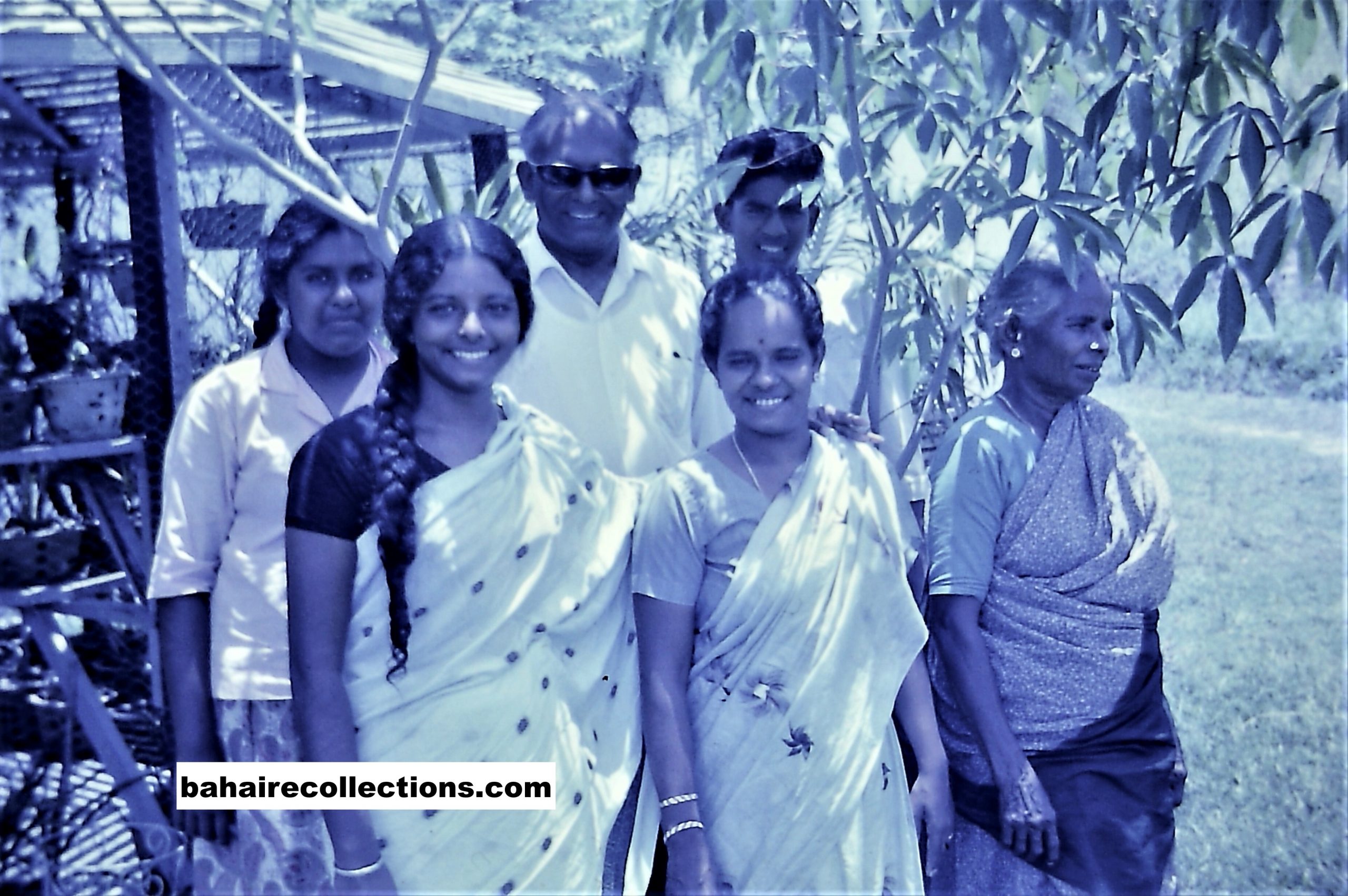
Appu Raman at the back with Karunanithi to his left. Front row L-R: Shamala, Swadesh, Madam Thanabakkiam, and her mother (Missing is Nalaini )
Raman was also a long-time member of the Local Spiritual Assembly of Kajang since it was first elected in 1965. With his base in Cheras, he was the prime mover of opening up several rubber plantation settlements called estates to the Faith in Selangor state. These estates had a large presence of indentured labourers originally from the state of Tamil Nadu in India and who spoke Tamil, a language that Raman was fluent in. Raman embraced teaching and opening of estate areas and deepening those believers as his personal goal, thus becoming a pioneer in that area of service and setting an exemplary record that was unrivalled or surpassed. That became his passionate area of service that he employed throughout his life. Raman opened up several rubber estates to the Faith, some of which were the Ampar Tenang Estate, Bangi Estate, Semenyih Estate, Dominion Estate, Dunedin Estate, Prang Besar Estate, Sedgely Estate, West Country Estate, and Braemar Estate, which today have given way to urban development and remain only in the pages of history. Raman paid personal attention to the development of these communities, making weekly and if needed, daily visits and in the course of these visits deepened and strengthened numerous individuals. He was there for all their family functions as well – marriages, funerals, and family gatherings, and thus truly became one of their friends. On many occasions, Raman personally and fully financed conferences held in the estates. One such event was a two day-long deepening session in a beach resort in Morib that Raman arranged during the school holidays in December 1967. The participants were the Tamil-speaking friends from the states of Selangor and Negeri Sembilan. He also led many of these estate communities in organising Ayyám-i-Há and Naw-Rúz celebrations. Raman trained and nurtured several Bahá’ís and Bahá’í communities, which produced strong believers, who themselves, in turn, took on individual teaching and administration initiatives.
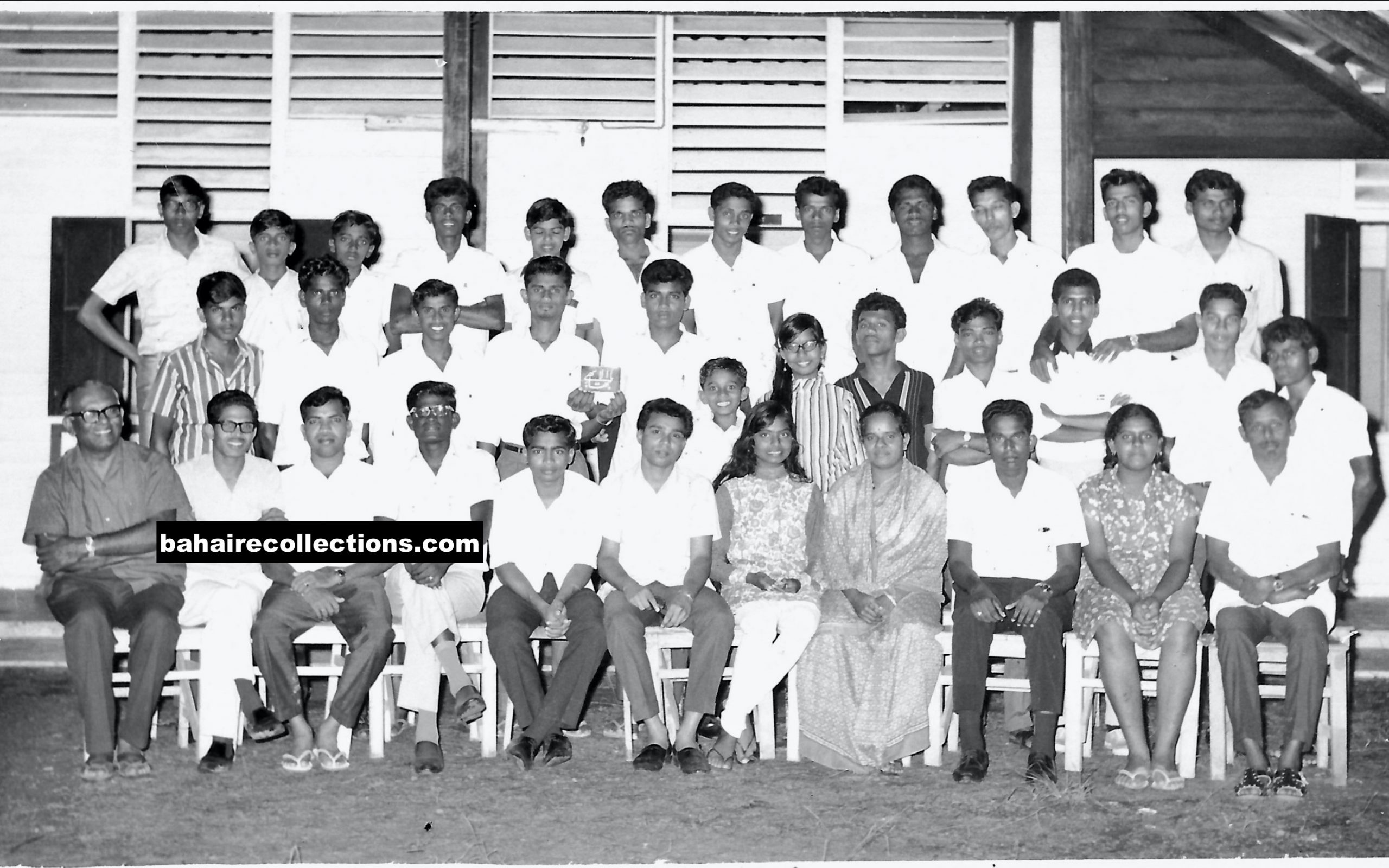
Raman, seated at the extreme left at a two day-long deepening session at a beach resort in Morib in December 1967.
Although busy serving a vast area in the state of Selangor, Raman was much sought out throughout the country, especially in Tamil- speaking communities, becoming a father figure for Tamil school teachers and Tamil-educated believers. In all his official travels across the country, he found ways to visit those Tamil-speaking communities, families, and isolated believers and Tamil schoolteachers. For the benefit of the Tamil-speaking believers, Raman translated the compilation of “Words of Wisdom” into the Tamil language and conducted deepening sessions with the believers. He was very well-organised in conducting deepening sessions for the Tamil-speaking friends. He would start a series of deepening sessions on specific topics and upon energetic and systematic completion, he would select another topic. His favourite was the stories related to the life of Bahá’u’lláh, especially on His infinite mercy, and the extraordinary powers of the Manifestation.

Raman teaching the Cause in an estate
Raman played a great role in handling opposition to believers in the estate communities through his deep knowledge of Hinduism and the Indian culture. He was a tower of strength for the believers in the estate areas, always providing strong and sustained support. He was very active in a wide range of activities that enabled him to penetrate both the English and Tamil speaking communities with his fluency in those languages. His house was a home for everyone. He was one of the favourite “uncles”, an endearing term of respect of the Malaysian Bahá’í youth who sought so much guidance and love from him in personal meetings with him and at youth gatherings. Bahá’ís flocked to his house seeking guidance, assistance, and clarification on the Faith.

Visit of friends to Appu Raman’s home, December 1968. Standing L-R: Dr. N. Soraya from Indonesia, Counselor Vasudevan from India, (Unknown) Appu Raman. Squatting L-R Choo Yeok Boon, R. K. Kannan, and another visitor
Raman also shouldered heavy responsibilities at the national level for the Faith from the time he returned from the United States. In 1963, Raman was the Secretary of the National Teaching Committee. In 1965, he was elected to the National Spiritual Assembly of Malaysia and served on that institution until 1971, the year in which he served as Chairman. He was on the Editorial Board of the Malaysian Bahá’í News magazine in 1965. In the early years of the Faith in Malaysia, he was instrumental in establishing the national Ḥaẓíratu’l-Quds, and kept visiting the Centre often from his home which was not far away, and provided whatever assistance that was needed. In 1966, he drafted the guidelines and rules for the National Bahá’í bookshop, and in the same year was appointed on to the Proclamation Committee and the Temple Site Committee.
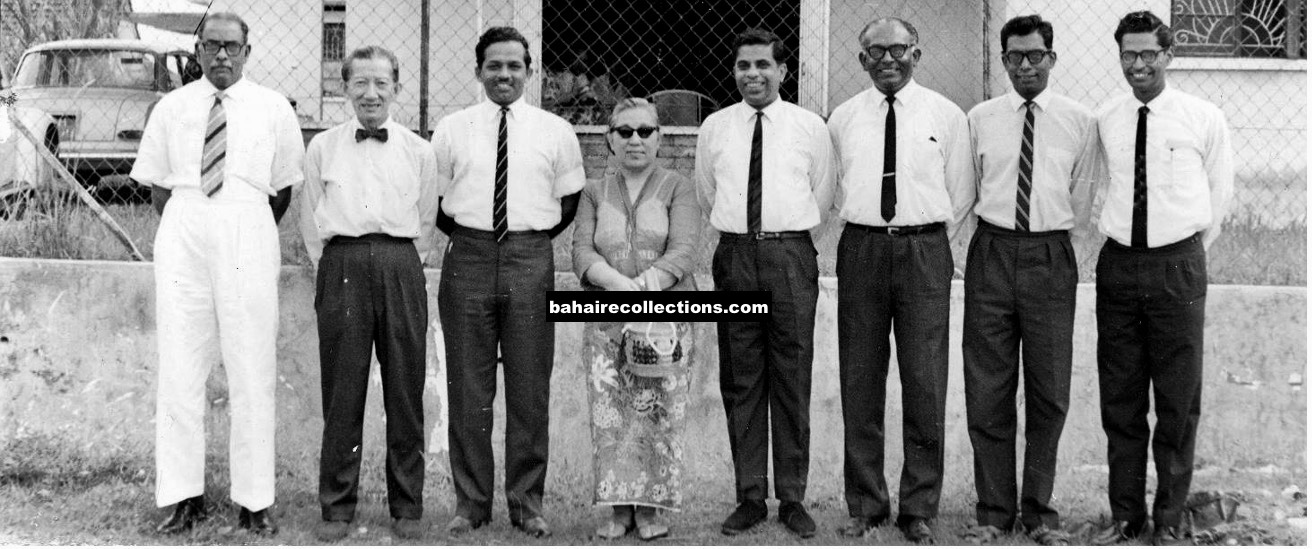
National Spiritual Assembly of 1965. L-R: K. Rajah, Yankee Leong, Anthony Fernandez, Mrs George Lee, Dr Chellie J. Sundram, Appu Raman, Inbum Chinniah, S. Vasudevan (Missing in Picture – Dr. John Fozdar)

First National Youth Seminar held at the New Era Bahá’í School above the Foh Hup Bus Station in Kajang town in April 1967. Seated L-R: R. K. Kannan, Tushar Kanti-Paul, Leong Tat Chee, Evelyn Ng, Lily Ng, Appu Raman, and Kathleen Kanti-Paul
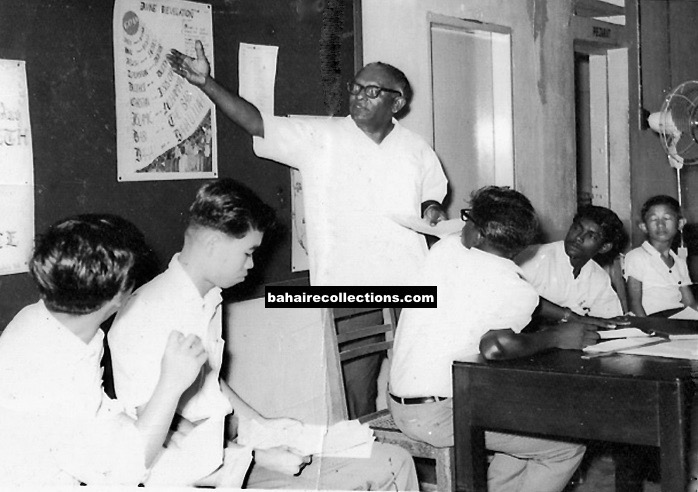
Raman at a deepening session at the National Youth Seminar of 1967. Second from the left is Lee Wai Kok from Kuala Pilah, and at the extreme right is Bennedict Chee, with Munusamy to his right
When in 1967 Hand of the Cause of God Dr Muhájir called for a One Week Proclamation events in many areas of the country, Raman was appointed Organizer of Public Meetings and he sent out detailed guidance to all Local Spiritual Assemblies. Many communities sprang into action, resulting in unprecedented publicity for the Cause. In 1971 he was appointed on the National Asli Teaching Committee, a committee set up to teach the indigenous Malaysians. In the years before his passing, he became actively involved in the Ulu Langat Local Spiritual Assembly and the project assigned to it by the National Spiritual Assembly, which is that of developing the newly acquired land in Balakong, on which was constructed Balakong Bahá’í Institute and later renamed the Yankee Leong Institute. In all these committees Raman served with great distinction and devotion.
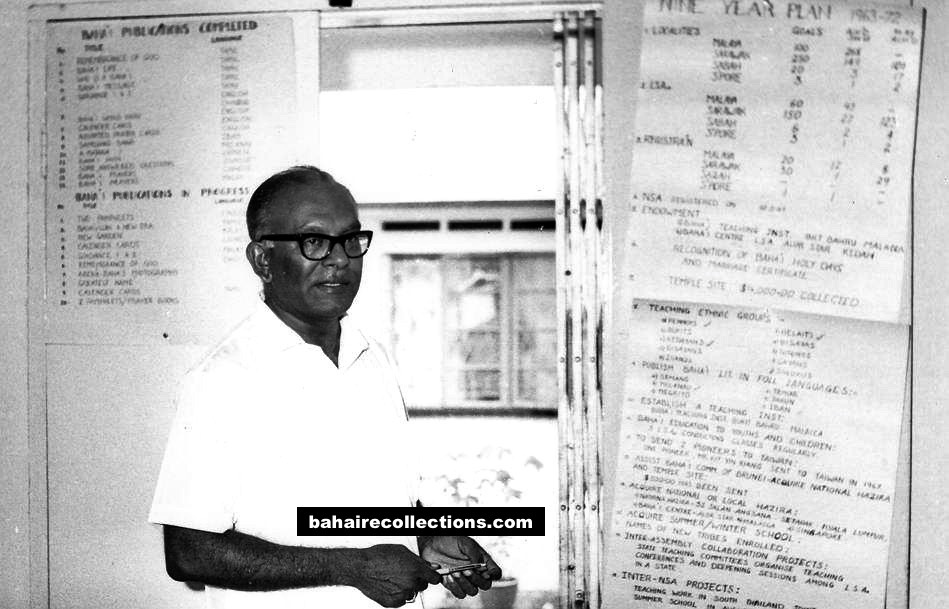
Raman explaining the goals of the Nine-Year Plan
Raman was travelled widely across the country from the time he returned from the United States in 1963. In September 1963 Raman spoke at a Public Talk that was organised at the Workers Union Hall Building in the remote town of Mentakab in the state of Pahang where 25 enquirers came. He was a speaker at the State Level Teaching Conference that was held at the Double Lion Hotel at Kuala Kangsar in early 1967. When Jeanne Frankel from the United States came to Malaysia for three months from June 1968, she went around the country to meet the communities, and Raman was tasked with accompanying her as a translator of her talks into Tamil in the Tamil-speaking areas.
In 1970 Raman gave a talk on the Bahá’í Faith over Radio Malaysia in Tamil at a primary airing time in the evening, giving the widest ever publicity for the Faith in the Tamil speaking community.
Raman was moved by the Ridvan message of 1971 from the Universal House of Justice that called upon the Bahá’ís of Malaysia to concentrate on teaching the Chinese in Hong Kong. In 1971, while still in civil service, he undertook a Bahá’í teaching mission to Hong Kong and Taiwan in the company of his wife. Raman must have been most galvanised by the message to embark on this visit for one who does not come from an ethnic Chinese background. After his brief visits to these countries, he went to the Bahá’í House of Worship in Wilmette in November 1971. In speaking of his visit to Hong Kong in Chicago, he referred to that city as “the doorway to China” through which the Message of Bahá’u’lláh would soon be carried to the teeming millions of people living in that vast land. He expressed that the all-important task of taking the Faith to China had to be undertaken by the Bahá’ís all over the world, especially the youth. He strongly urged the youth to start now to learn to speak Chinese and be ready for the opportunities that very soon will arise for mass teaching in the mainland of China. After visiting the friends he made in Michigan in his previous trip in 1962 the couple proceeded to New York and then to Washington where Raman consulted with persons in health and welfare education and service to the handicapped. From there they went to London to visit the resting place of the Guardian and the Bahá’í House of Worship in Germany.
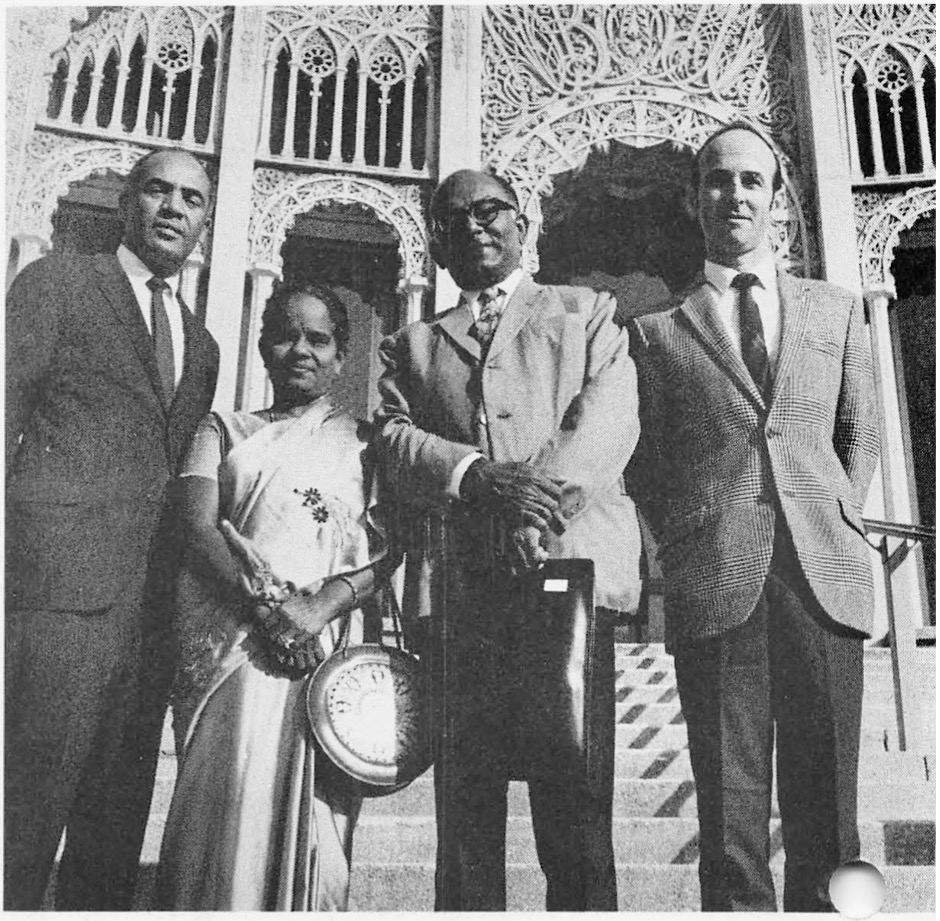
The Ramans at the centre, at the House of Worship in Wilmette, the USA with the Coordinators of the House of Worship, Mr. Caswell Ellis at left and Mr. Albert King at right (Photo courtesy: Bahá’í News, USA February 1972)
When Raman was not elected into the National Spiritual Assembly in 1972, he immediately switched his area of service to intensive field teaching, with a special focus on developing the Tamil-speaking individuals and communities in the country, an initiative he had already started in 1963 as he moved into Cheras upon returning from the USA. He was very clear that the field of service is indeed so vast and he became a protagonist in assisting the Tamil speaking communities, buoyed by the truth that there were very few Bahá’í literature translated into the Tamil language. Until the end of his life, Raman travelled to most of the communities across the country all alone, and only on occasions others accompanied him. Mr. Nagendran Nagalingam who was living in Seremban invited Raman to assist in teaching and consolidating the believers in a vast number of estates in Negeri Sembilan state effective 1972. For the next two years, Raman was constantly going to Negeri Sembilan almost every week for consolidating the believers in the estates and would return home past midnight. A few teaching conferences were held in the Jerampadang Estate, Batu Bersawah Division which had a high concentration of believers. In one of those conferences, he gave a deepening on how to hold Nineteen Day Feasts. Nagendran says there was no estate that Raman did not cover in Negeri Sembilan state. While assisting in the state of Negeri Sembilan, he exerted equal efforts in developing the communities in the state of Selangor. The believers of the Bangi Estate trained by Raman became the first community in West Malaysia to build its own Bahá’í Centre under the Five-Year Plan of 1974 to 1979. Raman was invited to officially open the centre in January 1975 in the presence of Bahá’ís from the states of Selangor and Negeri Sembilan. As that centre was built on Malay reserve land, it had to be later surrendered to the owners after a period of ten years.
Due to his influential personality, integrity, upright conduct, and high positions held, he was invited, and often pressurized to hold high political positions. A very prominent leader and Member of Parliament from the largest Indian-based political party felt that someone like Raman could be useful for the party and the community the party represented. History has it that Raman was one of the founding members of that largest Indian-based party, holding the position of Secretary-General of that party from 1947 to 1950 under its second President. That Member of Parliament met Raman by chance right in the middle of the Kuala Lumpur city, in front of the old Malayan Bank building and they conversed for an hour on the walkway, with the bystanders wondering what was going on between these two well-known figures. While the politician wanted Raman to work for his Indian race, Raman stood his ground that working for the entire human race was what the world needed today. The politician gave up after an hour’s attempt to lure Raman back into politics, but he parted with the highest respect for Raman, the Bahá’ís, and the Bahá’í Faith. Already in 1961 Raman made a firm decision to be of permanent service to the entire human race through the Cause of Bahá’u’lláh, a course from which nothing whatsoever could swerve him!
Raman’s desire to pioneer to some foreign country grew stronger as his days of retirement were inching nearer. Unable to contain his desire, he in November 1975 took a long leave from work to offer his services in a foreign country. Since Guyana was in need of assistance, Raman went to pioneer in Guyana. The Local Spiritual Assembly of Petaling Jaya threw a party in appreciation of his great gesture. But he had to return early owing to some developments in his family that needed his presence. His impactful services in Guyana are still well remembered to this day, as related by Rajamanickam Velu of Kuala Lumpur community who undertook travel teaching to Guyana from 1990 to 1996.
When Raman returned in 1975, he was back in service. In 1976, he fully retired from service. At the time of his retirement, he was holding a senior post as Deputy Director of Welfare Services in the Ministry of Welfare. His was an illustrious career. From 1965, Raman was the Principal of a rehabilitation center for the physically handicapped which not only provided vocational training for physically handicapped persons but also aided them to find employment. During his days in government service, he held important posts in humanitarian organisations and initiated several societies such as the Self-Reliant Society, the Association for the Physically Handicapped, and the Association for the Mentally Retarded.
Even while still in service in 1974, Raman and his colleague Mr Hugh Story initiated the formation of the Society of the Orthopaedically Handicapped Malaysia and was approved in September 1976. That became a society of the handicapped themselves and the membership swelled to more than one thousand within a short time.
Raman retired from service, but he was much remembered and appreciated by the Malaysian government. In recognition of his abilities and loyalty to the Malaysian government, he was appointed as a member of the Public Services Commission in 1976, a prestigious position hitherto not held by any other believer, thus adding further prestige to the Faith. It needs to be mentioned that throughout his two terms in that Commission, he was the only non-Malay to serve in that capacity. The Public Services Commission was tasked with interviewing candidates who applied for government jobs. There was no incidence of Raman showing favouritism to any candidate known to him. When he was asked to favour certain candidates he would reply, “Justice shall be done. You pray on your part, and I shall do my part with all honesty and in accordance with the books.” He never entertained recommendations coming from political leaders.
Raman was a very active supporter of the activities of the National Tamil Teaching Committee. He last spoke at the Tamil Winter School held in Stella Maris Bungalow in Port Dickson from 30 April 1981 to 3 May 1981. Yet another last major event in his life was a tea party organised by the Local Spiritual Assembly of Hulu Langat for the Orthopedically Handicapped at Cheras in commemoration of the United Nations Day on 24 October 1981. The United Nations declared 1981 as the International Year of the Disabled Persons and the Malaysian government had given some exemptions and perks for the disabled in its budget for the following year. Raman, who was the former Principal of the Rehabilitation School For The Physically Handicapped, took to the stage and announced the kind gesture of the Government in giving exemption to the handicapped in its budget and spoke in my fluent Malay language with such strong emotions that the audience of mostly handicapped persons showed their appreciation with thunderous applause at the end of his talk. The Bahá’í Youth choir entertained them with songs, with Judy Phung stealing the show with her Malay Pantun, to the tune of the “Rasa Sayang” song. Raman was very happy and radiant at this last major event before his own life came to a close.
In the last few weeks of his life, Raman had an inner urge to serve the Cause to a greater degree than what he had ever done before. Late night one day, he arrived at the house of the Secretary of the Local Spiritual Assembly of Hulu Langat and discussed how the Assembly and the community could serve the Cause with more activities, involving all members in the community. It seems that he could scarcely wait for a day to pass without rendering some service for the Cause. At the last few meetings of the Local Spiritual Assembly, he was suggesting stepping up the benchmark to serve with greater vigour and undertaking sacrificial efforts. He himself showed the way by volunteering to take up tasks, including the development of the newly purchased Bahá’í property in Balakong, on which was built the Yankee Leong Bahá’í Training Institute.
While alive Raman expressed many times his desire to have his bones buried overseas as a pioneer. In late December 1981, Raman undertook a four-month trip that would take him through Thailand, Burma (now known as Myanmar), Bangladesh, India, and Sri Lanka. He combined his two dreams in that trip. During the Second World War, Raman and his wife Madam Thanabakkiam were members of the Indian National Army in Malaya. On this trip, Raman wantedd to follow the path taken by the Indian National Army that marched from Malaya into Manipur state in India where the first headquarters of the Indian National Army was established. Secondly, though more prominently, he wanted to serve the Cause in all these countries he wanted to visit. A few weeks before embarking on this trip, he wrote to the believers in all these countries to organise activities for him. On 21 December 1981, his sixtieth birthday, he threw a simple dinner for selected friends at his residence, and his wife cooked his favourite dishes. He asked his wife to sing his favourite old Tamil song of the 1940s which she gladly did. Raman was in the happiest mood that night.
When he was making arrangements to leave for this trip, the Malaysian government requested him to continue his service as a member of the Public Services Commission for another term, in view of the fairness with which he had discharged his responsibilities. But Raman had already decided for a higher service for the Cause, and nothing could persuade him.
On 25 December he went to Butterworth town in the north, from where he intended to take a train to Bangkok from where he intended to continue his journey to Burma. There he met the community and gave a talk on the urgency to serve the Cause, and drove home the point that believers should be willing to arise to serve the Cause. While in Butterworth, he was met by Auxiliary Board member Mr V. Subramaniam fondly called V.S Maniam, of Sungei Petani. As they were talking news of the passing of his dear Bahá’í friend Mr C. Subramaniam in Sungei Siput was broken to them by the arrival of another local believer in Butterworth. Raman postponed his journey to Bangkok, and both of them rushed to Sungei Siput. The following day C. Subramaniam was actually scheduled to conduct a Bahá’í wedding for Mr G. Subramaniam and Miss Susila Nadesan in one nearby Kinta Valley Estate. Raman stepped in to conduct the wedding on behalf of his departed friend, rushing from the funeral home to the estate to conduct the wedding on 26 December. After the wedding, Raman and V. Subramaniam returned to Butterworth. Just before Raman boarded the train, he hugged Subramaniam and told him that he may not return from the journey that he was undertaking, and urged him to serve the Cause as never before.
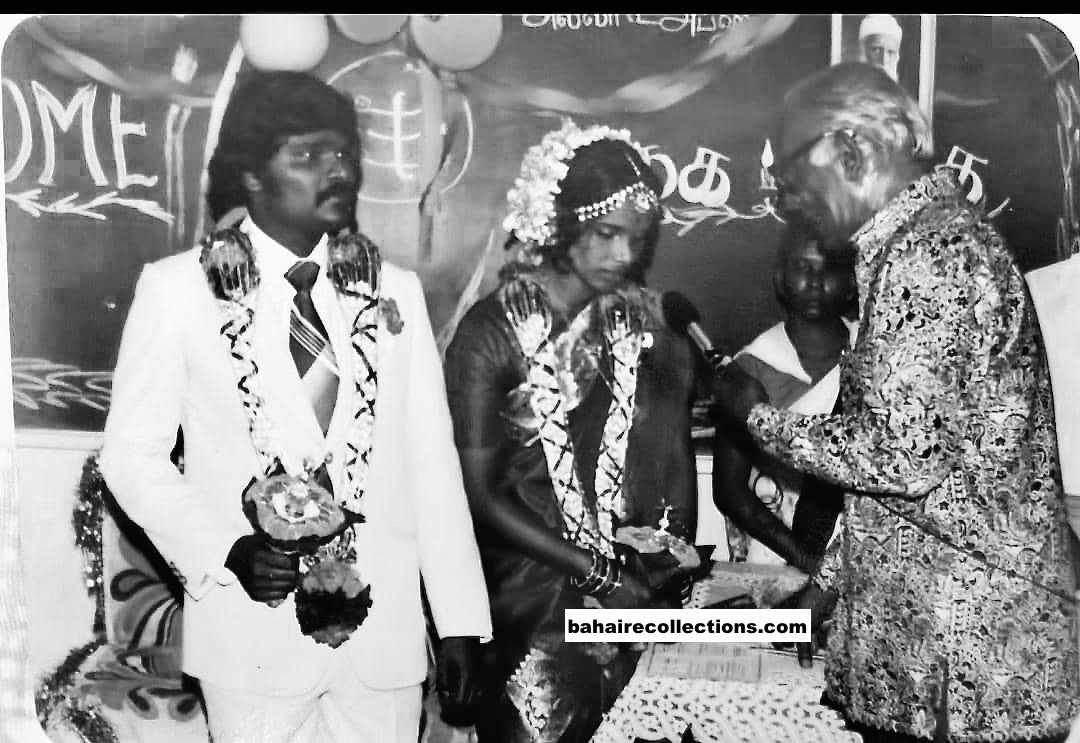
Raman conducts the wedding of G. Subramaniam and N. Suseela – his very last activity on the Malaysian soil
And he indeed never returned! While in Rangoon, Burma for a week, he visited along with Board members Mr U Tin Shwe and Mr U Shoe Tin the resting place of Hand of the Cause of God Siyyid Mustafá Rúmí in ‘Abdu’l-Bahá Village in Daidanow. U Shoe Tin was one with whom Raman moved very closely during his days in Yangon. At the Bahá’í Centre in Rangoon, he addressed the community, followed by home visits where he encouraged the friends to serve the Cause. It was reported that in all the meetings Raman had with the believers, he spoke with strong passion and force on the need to serve the Cause with greater sacrifice, as though he had some indication that his days on this earthly plane was to end soon. On 5 January 1982, he sustained a massive heart attack and passed away. The National Spiritual Assembly of Myanmar conveyed the tragic news to his family in Malaysia through the National Spiritual Assembly of Malaysia, and informed the Universal House of Justice as well. The unexpected and sudden passing sent shock waves through the Bahá’í community, and the friends rallied around the family to work out what to do in the circumstances. Swadesh Kumari, the eldest daughter of the Ramans living in India was informed and was requested to start her travel immediately to meet other family members in Bangkok. Mrs Thanabakkiam Appu Raman, Nalaini Appuraman, Kalavathy Appu Raman, and two other members of the Hulu Langat community – Jami Subramaniam and Ramayah Renggan started booking tickets to travel to Rangoon through Bangkok. They all arrived in Bangkok and waited for Swadesh Kumari to arrive from India. During that stopover they visited the Bahá’í Centre in Bangkok, where they met Mrs Shirin Fozdar, who had known Raman from her visit to Alor Star in 1961. She told them in no uncertain terms that Raman was already in a blissful place in the company of many other angelic souls that have ascended before him, and that the one thing that would gladden his soul was to offer prayers. When Shwadesh Kumari arrived the following day, they all flew into Rangoon. The burial of Raman’s body which was kept in the hospital mortuary awaiting the arrival of his family took place in the evening. A light drizzle mirrored the family’s grief.

Radiant and calm, as he was laid to rest.
It was after the burial had taken place that the Malaysian delegation was informed of the circumstances leading to the passing of Raman. While staying in the Dagon Hotel in Yangon, he had to climb the very steep staircase a few times each day, which was too stressing for Raman. After lunch on 5 January at the home of U Shoe Tin, Raman was conducting a session on the Will and Testament of Abdul Baha and spoke with such a force and passion on the need to be firm in the Covenant. Suddenly he started to sweat profusely and found it difficult to breathe. He was laid to rest on a bed. Realising that his condition was worrying, the friends asked him if he wanted to speak to his family in Malaysia over the phone. Raman replied, “You are my family.” The friends rushed him to hospital with the head of Raman resting on the lap of U Shoe Tin. Upon arrive in hospital he was pronounced dead, caused by massive heart attack.
Raman’s untimely passing in a foreign land fulfilled his long time desire to have his bones buried overseas as a pioneer left an irreparable loss to the Malaysian Bahá’í community. In Myanmar where he had won the love of the community, more than five hundred friends gathered at the funeral. As the Burmese friends carried Raman’s body from the hearse to the grave, with tears in their eyes, they realized that through him a permanent bond had been established between the communities of the Greatest Name in Burma and Malaysia. In his death in that country, there is a wisdom. This was the time when the Supreme Body had given Malaysia the goal of strengthening the Myanmar Bahá’í community. The National Spiritual Assembly of Burma reported that Faith had not been so well proclaimed in that land since the days of the Hand of the Cause of God Siyyid Mustafá Rúmí.
On 8 January 1982, the Universal House of Justice cabled the National Spiritual Assembly of Burma expressing the hope that the example set by Raman would inspire the believers there to intensify their service to the Faith.
And the National Assembly in Malaysia received the following cable from the Supreme Body:
GRIEVED PASSING DEVOTED SERVANT BAHAULLAH APPU RAMAN IN BURMA. HIS SACRIFICE FIELD SERVICE BAHAULLAH SHEDS LUSTRE YOUR COMMUNITY WHICH MAY WELL BE PROUD SPIRITUAL VICTORIES ACHIEVED BY ITS NUMEROUS DISTINGUISHED MEMBERS MANY FIELDS BAHAI SERVICE. ASSURE RELATIVES FRIENDS ARDENT PRAYERS PROGRESS HIS SOUL.
His passing was flashed in the Tamil Nesan Tamil daily of Malaysia, which gave a good write up on his early contributions to the Indian cause in Malaya in the early days. A week later, a simple and yet befitting memorial service was held in the National Bahá’í Centre in Setapak following an obituary placed in the local newspapers. Some members of the public, including one prominent politician who had seen the obituary joined in the memorial service. Counsellor Dr. Chellie J. Sundram spoke of the wonderful services rendered by Appu Raman and stressed that he lived truly by the principles of the Faith.
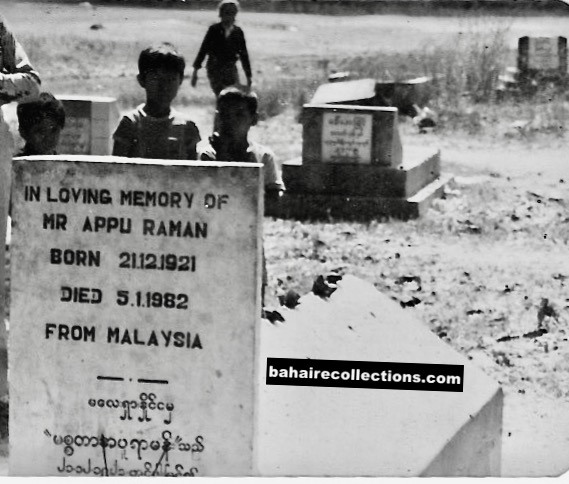
Original resting place of Appu Raman
When the Government of Myanmar wanted to develop the land on which Raman was buried along with others, the Bahá’ís were given an alternative site and the earthly remains of Raman were exhumed and reburied in a well maintained Bahá’í cemetery. Malaysian believers visiting Burma for teaching purposes or tourism never failed to visit the resting place of this true servant of the Cause and offer prayers, and the local believers took great pride in accompanying them.
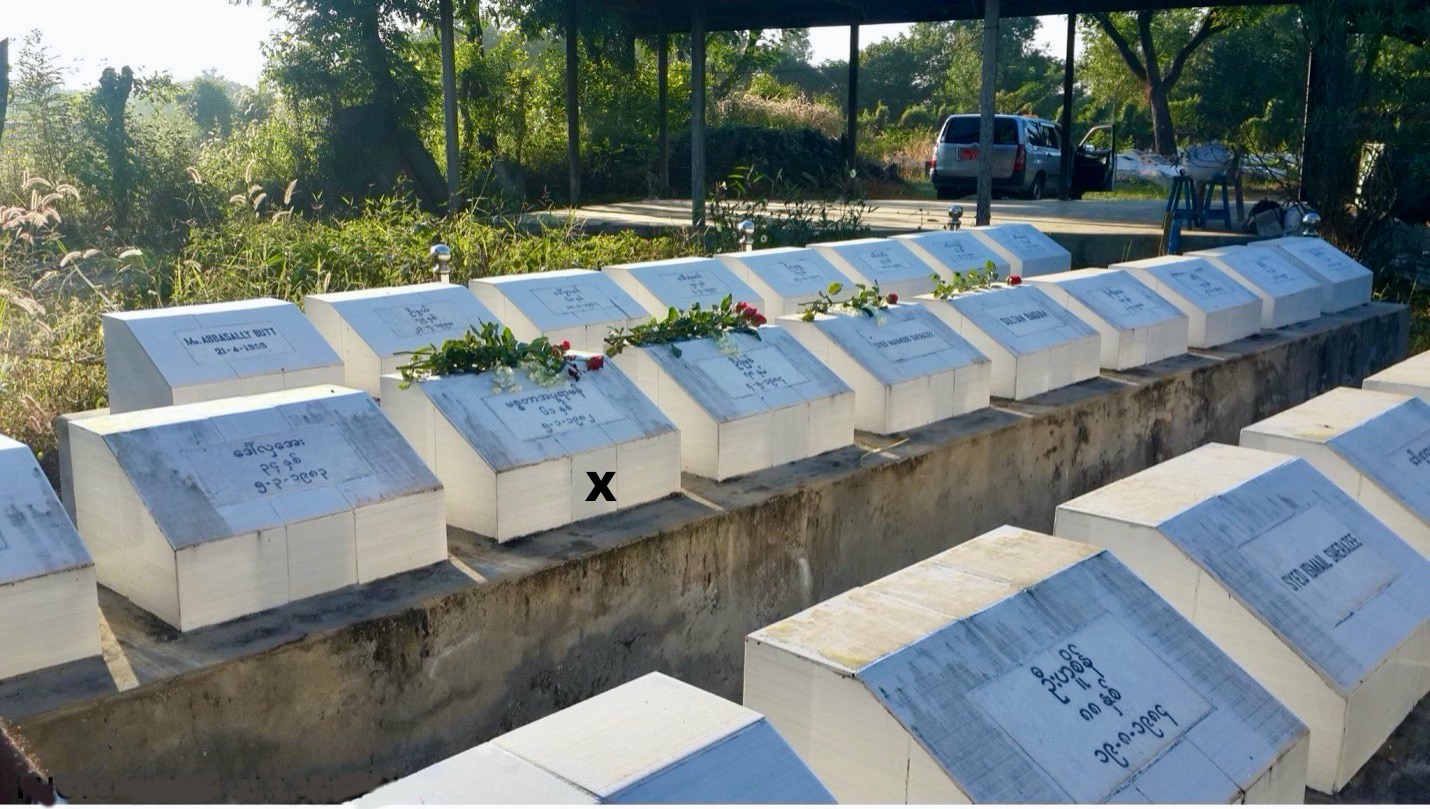
The stone marked “X” is where Raman’s remains are reburied in the current Bahá’í cemetery
Looking at the legacies left behind by Raman, many thoughts would naturally flood into one’s mind. As a genuine lover of mankind Raman was very much overcome with emotions when the believers in the cradle of the Faith were persecuted in 1979. While addressing their plight at a large Tamil-speaking audience in Sungei Petani community, he broke down. After a moment of silence, and wiping away his tears, he resumed his talk, charged with emotion. Whenever he received news of the someone admitted into hospital he would visit them. And whenever news of people suffering of poverty and hunger reached his ears, he would pack his car with provision and drive down to visit them, and offered some cash as well, promising continued assistance coming from him. Raman has quietly assisted in educating some poor students. There were many unemployed youth whom Raman financed to attend conferences. Raman never sought stages, microphones and prominence. There was never any reported incidence of Raman raising his voice when encountering provoking situations, but took up the matter with his Creator through prayers, and laid the matter to rest with Him.
Throughout his life Raman travelled extensively to several parts of the country for the purpose of teaching the Cause, and was often a well sought after speaker especially at firesides in Bahá’í societies in institutions of higher learning. He was often invited as a speaker at the United Nations Day observations, conferences and summer schools. Raman was also sought after for conducting many weddings both in the English and Tamil languages with his gift of fluency in both of these languages. He was one of those who provided training for the pioneers at the National Teaching Institute in Malacca in the early days.
Raman could have lived a very comfortable life, given his senior position held in the government service. But it was his choice to live in a simple terrace house, which was open to everyone and anyone. When his children were growing into adulthood, he bought a bungalow house in the prestigious Damansara Heights in the suburban area of Kuala Lumpur city to offer them some comfort. But as his children got married and moved out, Raman returned to his terrace house in Cheras, after a very brief period of three years in that bungalow. Likewise, he owned a simple Datsun 666 car which he used for many years. He dressed in a way that was an example to the rich and a consolation to the poor, with the national batik shirt being his favourite. His joy was to be with simple people with whom associated till the end of his life.
Towards the end of his life, he was planning to write a book on the fulfilment of Hindu prophecies in the Bahá’í Faith. He collected a large number of books on Hinduism and stacked these up in his reading room. His vast knowledge of Hinduism and the Indian culture would have certainly made that book is completed, an invaluable addition to the Bahá’í literature. Sadly, the manuscript had just an introductory chapter.
The gratitude Raman had for his Spiritual Mother needs a special mention. If Raman had to pass through Ipoh town to which Theresa Chee of Alor Star had been transferred in 1964, he never failed to drop in to visit her, which brought much happiness to both of them.
Raman faced several tests and difficulties and under normal circumstances anyone would crumble. But he soldiered on knowing fully well that he was under the protection of Bahá’u’lláh. His strongest weapon was the power of Divine Assistance that he always invoked through ardent prayers. He would advise friends to be careful of the kind of prayers they selected. He would say in jest, “If you pray to make me a dust in the path of Thy loved ones,” be ready for what is in store for you the next day.” He would also say, “Sometimes the violent tests of God would be like the fist of a bouncer about to hit your face at lightning speed, but before you realise, it would still miss you, to your surprise. Therein comes Bahá’u’lláh to rescue you.” Such expressions were born out of the answers God had given him on many occasions. He never flinched holding fast to the Bahá’í teachings and made sure that both his life and death were for his Creator alone.
Raman seemed to have been born with a burning desire to serve humanity, and the door opened when he accepted the Faith in 1961 in Alor Star. On the day Raman accepted the Faith, Theresa Chee asked him if there was anything he wished, to which Raman looked at the picture of the Mother Temple of the West in Chicago hung on the wall and said, “Perhaps I want to go there.” That was not just a casual statement that he made. His wishes were granted, and Raman went to the Temple in Chicago on three different occasions during his lifetime. He also was privileged to attend the first Bahá’í World Congress in London in 1963, go to the cradle of the Faith in Iran, and to the Holy Land as well. From the time Raman accepted the Faith, the guiding principle in his life was “Work is Worship; Service is Prayer” which he employed in his civil service and the service for the Cause. Raman had truly added lusture to the civil service and the service for the Cause.
Raman was one who arose and led the way on individual initiative and blazoned an exemplary path of service. Thus came to an end a Bahá’í life well-lived with a shining example of full devotion and dedication to the Cause of Bahá’u’lláh, and setting a standard for the current and future generations to emulate.
A. Manisegaran
31 May 2021
Copyright@bahairecollections.com
Comments can be posted through: info@bahairecollections.com